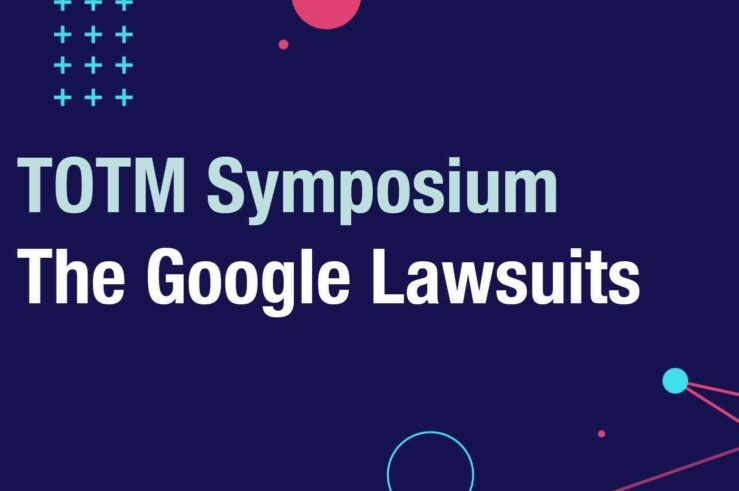AICOA Is Neither Urgently Needed Nor Good: A Response to Professors Scott Morton, Salop, and Dinielli
Earlier this month, Professors Fiona Scott Morton, Steve Salop, and David Dinielli penned a letter expressing their “strong support” for the proposed American Innovation and Choice Online Act (AICOA). In the letter, the professors address criticisms of AICOA and urge its approval, despite possible imperfections. “Perhaps this bill could be made better if we lived in ... AICOA Is Neither Urgently Needed Nor Good: A Response to Professors Scott Morton, Salop, and Dinielli
In Apple v Epic, 9th Circuit Should Remember that Antitrust Forbids Enhancing, not Exercising, Market Power
On March 31, I and several other law and economics scholars filed an amicus brief in Epic Games v. Apple, which is on appeal to the U.S. Court of Appeals for Ninth Circuit. In this post, I summarize the central arguments of the brief, which was joined by Alden Abbott, Henry Butler, Alan Meese, Aurelien ... In Apple v Epic, 9th Circuit Should Remember that Antitrust Forbids Enhancing, not Exercising, Market Power
Bad Blood at the FTC
John Carreyrou’s marvelous book Bad Blood chronicles the rise and fall of Theranos, the one-time Silicon Valley darling that was revealed to be a house of cards.[1] Theranos’s Svengali-like founder, Elizabeth Holmes, convinced scores of savvy business people (mainly older men) that her company was developing a machine that could detect all manner of maladies from ... Bad Blood at the FTC
Why the Federal Government’s Antitrust Case Against Google Should—and Likely Will—Fail
On October 20, 2020, the U.S. Department of Justice (DOJ) and eleven states with Republican attorneys general sued Google for monopolizing and attempting to monopolize the markets for general internet search services, search advertising, and “general search text” advertising (i.e., ads that resemble search results). Last week, California joined the lawsuit, making it a bipartisan ... Why the Federal Government’s Antitrust Case Against Google Should—and Likely Will—Fail
The FTC’s Errors in 1-800 Contacts
In an amicus brief filed last Friday, a diverse group of antitrust scholars joined the Washington Legal Foundation in urging the U.S. Court of Appeals for the Second Circuit to vacate the Federal Trade Commission’s misguided 1-800 Contacts decision. Reasoning that 1-800’s settlements of trademark disputes were “inherently suspect,” the FTC condemned the settlements under ... The FTC’s Errors in 1-800 Contacts
Exploring “First Principles” for Optimal Regulation
In my fifteen years as a law professor, I’ve become convinced that there’s a hole in the law school curriculum. When it comes to regulation, we focus intently on the process of regulating and the interpretation of rules (see, e.g., typical administrative law and “leg/reg” courses), but we rarely teach students what, as a matter ... Exploring “First Principles” for Optimal Regulation
Why Negative Externalities Don’t Justify a Tax on Employers that Drive Up Demand for Housing
Writing in the New York Times, journalist E. Tammy Kim recently called for Seattle and other pricey, high-tech hubs to impose a special tax on Microsoft and other large employers of high-paid workers. Efficiency demands such a tax, she says, because those companies are imposing a negative externality: By driving up demand for housing, they ... Why Negative Externalities Don’t Justify a Tax on Employers that Drive Up Demand for Housing
Lambert & Sykuta Comment to FTC on Common Ownership
The Federal Trade Commission will soon hold hearings on Competition and Consumer Protection in the 21st Century. The topics to be considered include: The state of antitrust and consumer protection law and enforcement, and their development, since the [1995] Pitofsky hearings; Competition and consumer protection issues in communication, information and media technology networks; The identification ... Lambert & Sykuta Comment to FTC on Common Ownership
Lowering the Barriers to Entry to the Common Ownership Debate: A (Relatively) Non-Technical Explanation of MHHI Delta
One of the hottest topics in antitrust these days is institutional investors’ common ownership of the stock of competing firms. Large investment companies like BlackRock, Vanguard, State Street, and Fidelity offer index and actively managed mutual funds that are invested in thousands of companies. In many concentrated industries, these institutional investors are “intra-industry diversified,” meaning ... Lowering the Barriers to Entry to the Common Ownership Debate: A (Relatively) Non-Technical Explanation of MHHI Delta
Correcting the Federalist Society Review’s Mischaracterization of How to Regulate
Ours is not an age of nuance. It’s an age of tribalism, of teams—“Yer either fer us or agin’ us!” Perhaps I should have been less surprised, then, when I read the unfavorable review of my book How to Regulate in, of all places, the Federalist Society Review. I had expected some positive feedback from ... Correcting the Federalist Society Review’s Mischaracterization of How to Regulate
Dear Antitrusters: Bias Is Ubiquitous. Stick to the Merits.
A recent tweet by Lina Khan, discussing yesterday’s American Express decision, exemplifies an unfortunate trend in contemporary antitrust discourse. Khan wrote: The economists cited by the Second Circuit (whose opinion SCOTUS affirms) for the analysis of ‘two-sided’ [markets] all had financial links to the credit card sector, as we point out in FN 4 [link ... Dear Antitrusters: Bias Is Ubiquitous. Stick to the Merits.
Problems with Proposed Solutions to the Common Ownership Problem
Even if institutional investors’ common ownership of small stakes in competing firms did cause some softening of market competition—a claim that is both suspect as a theoretical matter and empirically shaky—the policy solutions common ownership critics have proposed would do more harm than good. Einer Elhauge has called for public and private lawsuits against institutional ... Problems with Proposed Solutions to the Common Ownership Problem









